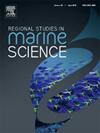基于SWAT模型的松花江流域人类活动对输沙量的影响
IF 2.4
4区 环境科学与生态学
Q3 ECOLOGY
引用次数: 0
摘要
人类活动是导致泥沙负荷变化的重要因素。许多研究利用数理统计方法(如线性回归)评估人类活动对泥沙负荷的影响,而没有考虑泥沙输运的物理过程。本研究旨在利用分布式水文模型重建自然条件下松花江流域的输沙量,并评估人类活动对松花江流域输沙量的影响。采用双累积曲线法确定降水径流随沙量变化的突变点。此外,利用水土评估工具(SWAT)模拟自然条件下的泥沙负荷,量化人类活动对泥沙负荷的影响。结果表明,流域降水和径流量变化不显著(P >; 0.05),而泥沙负荷变化显著(P <; 0.001)。年、月尺度上Ens和R2均大于0.4,Re均小于10 %。这些结果表明,SWAT模型可以有效地模拟SSRB的径流和泥沙负荷。1978-2014年,人类活动导致沙量减少2.11 × 105 t,占总沙量的57.02 %。泥沙负荷的减少主要是由水利工程引起的,水利工程通过截留上游泥沙和调节洪水减少了流域的泥沙负荷。研究结果可为流域水土保持和灾害预警提供参考。本文章由计算机程序翻译,如有差异,请以英文原文为准。
Assessing the effect of human activity on sediment load in the Second Songhua River Basin, Northeast China, based on the SWAT model
Human activity is a significant factor contributing to sediment load changes. Many studies have assessed the effect of human activity on sediment load using mathematical statistical methods, such as linear regression, without considering the physical processes of sediment transport. This study aims to use a distributed hydrological model to reconstruct the sediment load under natural conditions and assess the effect of human activity on sediment load in the Second Songhua River Basin (SSRB), Northeast China. The double cumulative curve method is applied to identify the point where the relationship between precipitation and runoff with sediment load changes abruptly. In addition, it employs the Soil and Water Assessment Tool (SWAT) to simulate sediment load under natural conditions to quantify the impact of human activities on sediment load. The results indicated that precipitation and runoff exhibit insignificant changes (P > 0.05), while the sediment load shows a significant decrease (P < 0.001) in the SSRB. Ens and R2 are greater than 0.4, and Re is less than 10 % on annual and monthly scales. These outcomes demonstrated that the SWAT model can effectively simulate runoff and sediment load in the SSRB. From 1978–2014, human activities led to a decrease of 2.11 × 105 t in sediment load, accounting for 57.02 % of the total sediment load. The decrease in sediment load is primarily caused by water conservancy projects, which reduce sediment load in the basin by trapping upstream sediment and regulating flood flows. These results can provide references for soil and water conservation and disaster warning in the basin.
求助全文
通过发布文献求助,成功后即可免费获取论文全文。
去求助
来源期刊

Regional Studies in Marine Science
Agricultural and Biological Sciences-Ecology, Evolution, Behavior and Systematics
CiteScore
3.90
自引率
4.80%
发文量
336
审稿时长
69 days
期刊介绍:
REGIONAL STUDIES IN MARINE SCIENCE will publish scientifically sound papers on regional aspects of maritime and marine resources in estuaries, coastal zones, continental shelf, the seas and oceans.
 求助内容:
求助内容: 应助结果提醒方式:
应助结果提醒方式:


